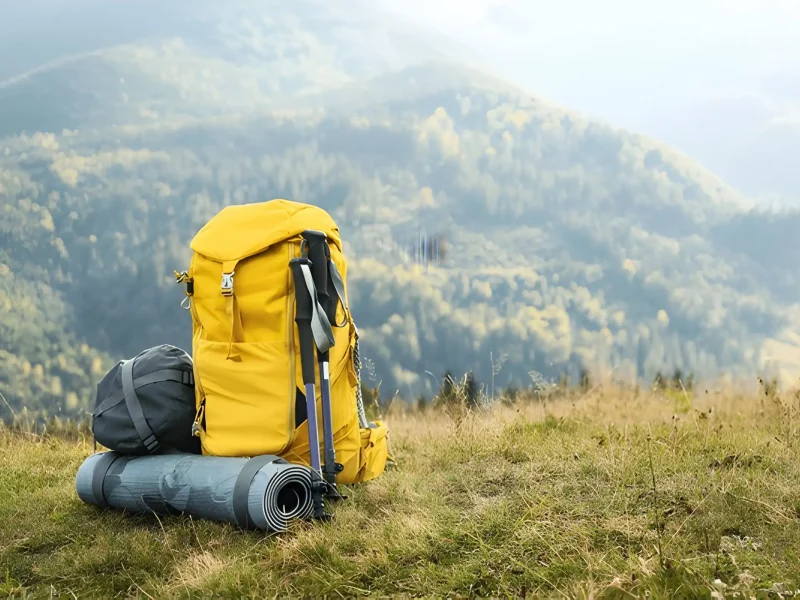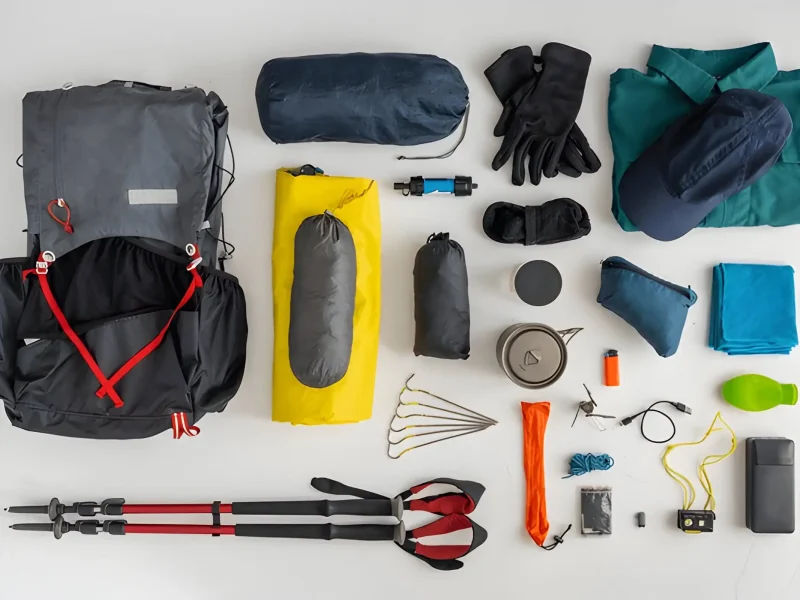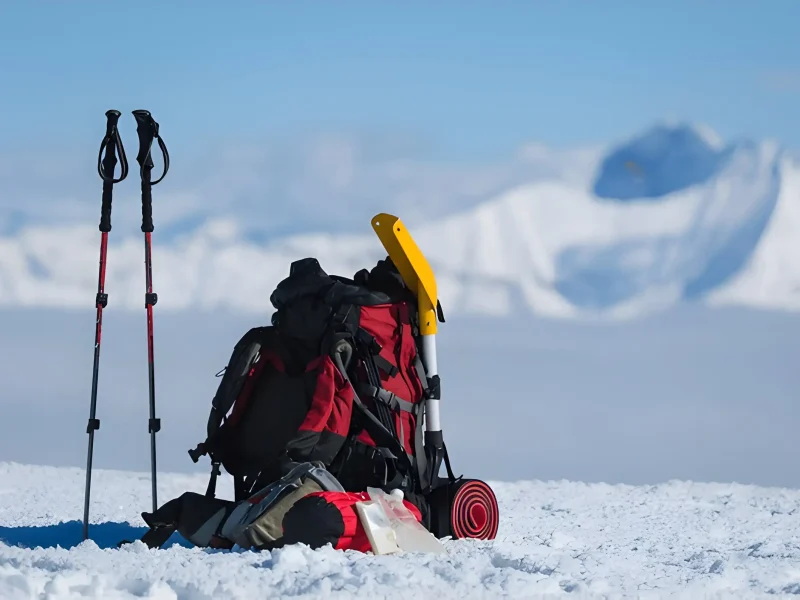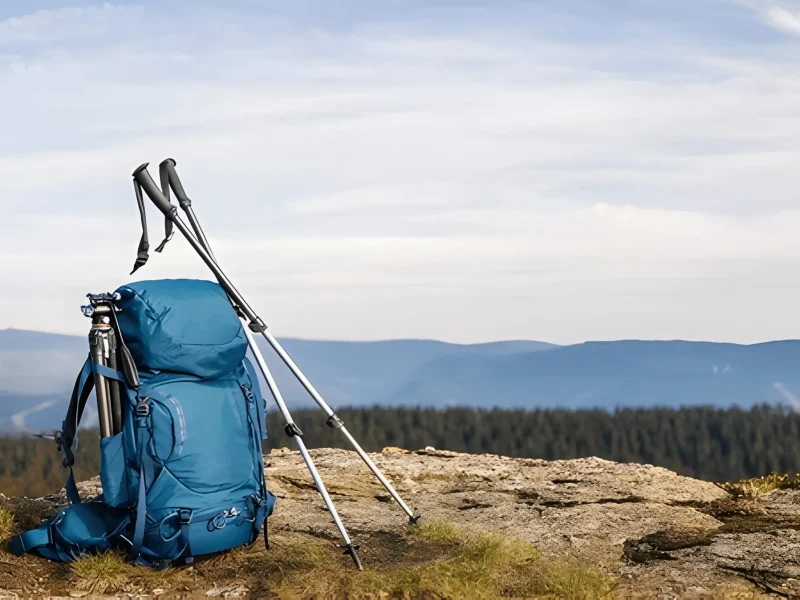When you’re on a trek, your goal is not just to complete the journey but also to enjoy the trip. While it might not seem that way, one of the factors that can contribute to a trekker’s trekking experience is the information on how to pack backpack for trekking.
Knowing how to pack a trekking backpack and following efficient packing techniques, you will prevent any kind of injury, be able to stay organized, and make your trek effortless.
To all the fellow trekkers and adventure enthusiasts who are looking to explore the raw hills and mountains of Nepal, by learning how to pack a trekking backpack, you will have a successful trek that is comfortable and safe.
Read on if you want to find out everything about how to pack a trekking backpack.
How to Pack a Trekking Backpack: Choosing the Right Backpack
A perfect trek begins with the right kind of backpack. A good backpack is also a major component of how to pack a trekking backpack. If you want to ensure that you have all the items required for the trek, you need to know how to pack a trekking backpack. Now, there are different types of haversacks available in the market. You need to choose a haversack depending on what kind of journey you’re going for and that best suits your purpose. Here are a few of the backpack types that are easily available in the market.
Hydration Packs
Hydration Packs are generally not meant for trekking, but they could be used for short hikes. These are used generally by the runners, and as the name suggests, these are used primarily to store water that helps them stay hydrated during a run. Hydration Packs have a capacity of 2 liters to 5 liters, and they have two storage compartments—one for the fluid and the other for quick access. They are made up of soft nylon that is waterproof.
In general, these backpacks offer adjustable shoulder straps and size stabilizers that make carrying them quite comfortable for the users. There is commonly no room for a first aid kit, extra clothing or compass/map. You could carry some snacks in the front compartment, though. These backpacks are easily available in hiking equipment store. You can use it optimally by knowing how to pack backpack for trekking.
Ultralight Daypacks
Though these are slightly bigger than hydration packs and offer rooms for storing a few more items, they are only considered fit for long distance runners or short hikers. Some sports enthusiasts also consider them to be fit for camping, as there are quite a bit of variations that exist. Capacity wise, they can be between 15 liters to 20 liters in volume. You can use it optimally by knowing how to pack backpack for trekking.
Apart from fluid, they can store a first aid kit, map/ compass, an extra layer of clothing, and snacks based on size. All in all lightweight trekking gear! Good quality items are made with water and tear proof nylon material. Most of these backpacks have adjustable and comfortable shoulder straps. They have one main compartment, two easy access side compartments, and one front compartment. These also come with pack covers or rain covers.
Daypacks
Size and Capacity wise, daypacks are bigger and more functional than ultralight daypacks. Daypacks are considered to be ideal for day-long hikes, but few adventurers also prefer using it during overnight camping trips. The capacity of daypacks is normally around 35 liters. When it comes to the number of compartments, they can be the same as or more than ultralight daypacks depending on the build and design. You can use it optimally by knowing how to pack backpack for trekking.
With features such as soft adjustable shoulder straps, comfortable chest and waist straps and water resistance, some of these daypacks are also completely foldable. For additional comfort, there is padding on the body and the shoulder straps. Good quality daypacks are often made of durable material like nylon, and have equal weight distribution throughout its body. These are ideal for carrying lightweight trekking gear.
Mid-range Backpacks
Mid-range Backpacks have a capacity of up to 60 liters. They are simply bigger and built stronger than regular daypacks. Mid-range Backpacks are considered to be ideal for trips that last a couple of days. For a short trek in the hills, you need to get your hands on this type of backpack. One of the best things about this backpack is that there are numerous customized compartments, including side pockets, that allow you to store items like electronic items, survival kit, and so on. Some of these bags also come with organizers to help you organize the items you have carried. This is one of the best trekking packs out there.
These are waterproof and made of durable material like nylon.Quite like other good quality backpacks, these also come with adjustable shoulder, chest and waist straps. For comfort, padding is added to the shoulder straps. An extra rain cover is offered with the backpack which makes it further weatherproof. You can use it optimally by knowing how to pack backpack for trekking. These backpacks are easily available in hiking equipment store.
Multi-day Backpacks
Multi-day Backpacks are probably the biggest and most durable among all the backpacks and that is why they are meant for long treks and vacations. The capacity could be between 85 liters to 105 liters and beyond. Good quality multi-day backpacks have a suspension system that allows you to adjust the size of shoulder and waist straps and torso. The bag can be adjusted to fit the size of the user’s body, and it provides stability, so that the user can easily walk on the rough terrain of rural countryside.
Apart from all the compartments where all sorts of things can be stored, including clothings and gear, the backpack also offers easy access side pockets and front pockets. These backpacks are made up of durable materials that make them weatherproof. This is one of the best trekking packs out there. You can use it optimally by knowing how to pack backpack for trekking.
How to Pack a Trekking Backpack: Essential Gear and Equipment to Pack
You need to be quite mindful about how to pack a trekking backpack, what things you should be packing and what things you should leave behind. Also, refrain from buying cheap trekking gear. The following are some of the essential gear and equipment that you shouldn’t leave behind.
Clothing
You should carry the right kind of clothing depending on what weather condition you’re planning to face out there. It is generally a good idea to pack at least three layers of clothing—base layers, insulating layers and waterproof layers since it will be pretty cold out there. It might get quite heated up during the trek so be prepared to take at least the first layer off during the walk.
Footwear
Since you’ll be trekking on tough and uneven terrain, it’s considered a good idea to invest on shoes that are high quality. Good quality trekking shoes and socks will make your walk comfortable, keep your feet dry, and help you avoid unnecessary pain and exhaustion.
Sleeping Gear
Now, you may not need sleeping gear if you’re going for teahouse trek, but if you’re a camper, it’s a good idea to invest in a good quality sleeping bag and sleeping pad. Refrain from purchasing cheap trekking gear. They need to be warm and comfortable. It is recommended that you carry a sleeping bag and a sleeping pad when you’re trekking during peak season. During these times, you may not get rooms to rest in at the end of the day.
Cooking and Eating Supplies
If you’re on a camp trek, it is recommended that you carry a portable stove, cooking utensils, and food packs. You will have a much better experience if you’re trekking with a group. Carrying and managing all these items will be easier. On a teahouse trek, you won’t need any of these. You could carry some snacks though to keep yourself energized during the trek.
Navigation and Safety Gear
If you’re traveling with a trekking partner, you wouldn’t need any of these items. But still, it is recommended that you carry outdoor trekking gear like maps, compass, GPS, first aid kit, and emergency communication devices. These items will prove to be handy in case you want to leave your group for a while and go on side treks on your own, or if you’re trekking independently overall.
Step-by-Step Guide: How to Pack a Trekking Backpack Efficiently
When you’re packing for a trekking journey, make sure to pack all the heavy and rarely used items, like sleeping bag and extra layers of clothing at the bottom of the bag. It’s better if you buy a backpack with a sleeping bag compartment. In the middle of the pack, pack heavy yet more frequently used items like cooking kit, food supply and water supply. This is practical and also helps you maintain the center of gravity.
On the top of your bag, carry items like rain jacket, snacks and first aid kit that you’ll be able to access quickly. Light outdoor trekking gear also needs to be kept on the top. For widely used items like water bottles, maps, sunscreen, headlampsand so on, use outer pockets. Finally, use hip belt pockets for items like light snacks and a multi-tool. Hip belt pockets can also be used to store small cameras or electronic devices. When you purchase a trekking backpack, make sure that you have all these compartments.
Tips for Organizing Your Gear
If you want to organize your bag in the best possible way, you don’t just need the right gear for it, but also know how to pack a trekking backpack. Get your hands on a couple of packing cubes and stuff sacks so that you’re able to store your items in a more organized manner on the basis of category and accessibility. In the same way, you can save space by compressing your bulky clothing and sleeping gear. For this purpose, you would require compression bags.
The weather on the trekking route can be quite unpredictable, so make sure to carry dry bags. They are important for waterproofing. You could keep your electronics and documents safe during rain and river crossings by storing them in these bags.
Balancing and Adjusting Your Backpack
Apart from how to pack a trekking backpack, an important factor that you should definitely look into is the balance aspect of your backpack. You must ensure that you balance your backpack well, as you will carry it throughout your journey. Be ready to make adjustments if it is not.
In this whole balancing process, proper weight distribution plays the main role. Organizing trekking equipment on the basis of their weight will help you achieve that. You need to adjust your shoulder straps and hip belts in such a way that they’re neither too loose nor too tight, and are comfortable enough to allow you to carry the bag for the whole day.
Don’t refrain from packing and unpacking your trekking equipment a couple of times to ensure that your backpack is well balanced. Carry the backpack everytime you make adjustments to see if it’s working for you or not. Measure the weight of your bag to be sure that you’re not carrying a load that’s beyond your capacity.
Packing for Different Conditions
Before you pack, you should know how to pack a trekking backpack. Additionally, it’s important that you think about what kind of year it is, weather conditions, any kind of danger that you might come across, and so on. Depending on all these circumstances, you should prepare to face the worst and pack the right items.
Packing for Wet and Rainy Conditions
Generally, experts recommend not going on a trek during wet and rainy seasons. However, if you’re an adventurer who has already decided to challenge yourself, remember to pack accordingly. Firstly, get your hands on bags that are completely waterproof and weatherproof. For additional protection, you could also use pack covers or rain covers. Don’t forget rain jackets!. Buy rain jackets that are durable and offer complete protection. Emphasize on storing your gear properly so that moisture doesn’t destroy them.
Packing for Cold Weather
It’s quite challenging to trek in the hills and mountains of Nepal during cold seasons so carry the right kind of winter trekking gear. However, if you have made up your mind, prepare yourself well. To avoid making your backpack heavy, choose clothes with lightweight fabric but the ones that keep you warm. Don’t compromise on insulation, as it’s going to be pretty chilly out there. Carry extra layers of clothing and a good-quality sleeping bag just in case the cold gets out of hand. Bags with a sleeping bag compartment might prove to be handy. The right winter trekking gear will make your trek more comfortable.
Packing for High Altitude Treks
Since you’re going for a high-altitude trek, it is absolutely important that you know how to pack a trekking backpack, and that you’re prepared for extreme cold, mainly altitude sickness. Talk to your doctor before going on the trip and find out what food items best suit your body at high altitude and what food items to avoid. In the same way, also carry a bunch of pills, including water filter pills, that help to keep common ailments like stomach disorders, fever, and so on at check. Carry pills that will allow you to keep altitude sickness at check as well.
Common Mistakes to Avoid
While packing a trekking backpack, there are a few common mistakes that trekkers can make. These mistakes can be avoided easily by getting to know how to pack a trekking backpack, and with a little bit of thought put into the packing process.
Overpacking
Don’t forget to carry only the things that you require during the trip. Pay special focus on how to pack a trekking backpack. Some people tend to carry extra items to prepare for emergencies. This way, you may not be able to maintain your center of gravity, especially if your bag gets too heavy. You shouldn’t carry so many extra items that it gets hard for you to carry your luggage. The right thing to do is to make a list of all the items that you’re going to carry. Don’t forget necessity and your ability to carry the weight of the luggage when it comes to deciding what to carry.
Underpacking
Underpacking is yet another common mistake that you need to avoid. You can do so by getting to know how to pack a trekking backpack. Some travelers are determined to travel light, and in the process, they end up not carrying items that could be crucial for them. It’s a trekking trip that might last for days, so you should pack enough clothes, a first aid kit, water purification tablets, and the right trekking gear. If you’re not sure about what things to carry, you could ask your trekking partner what you should pack, including.
Incorrect Placement
Your luggage might consist of all sorts of things, from heavy items to light items. It’s important that you maintain your center of gravity by placing all these items in the right order. Pack strong and heavy items at the bottom, while placing light and fragile items on the top. Packing order of things is significant as it allows you to access things easily. On top of that, you’re also able to have a comfortable bag-carrying experience and avoid any kind of imbalance or discomfort if you pack your things right. These things hold much importance, especially on long journeys where you need to walk.
Trekking Food and Water Management
Apart from the best trekking gear and getting to know how to pack a trekking backpack, food and water are also significant aspects of any trek. You’d generally not have to worry about them if you’re trekking with a trekking partner. They will take care of all your meals, and constantly remind you if you need to carry water or additional snacks during your trip or not. However, if you’re traveling on your own and doing a camp trek instead of a teahouse trek, you will have to put special emphasis on food and water. You want to stay energized throughout your trip and not fall sick by any means.
Choosing the Right Food
The food that you eat needs to be right for your belly. Don’t eat the kind of food that puts strain on your body. You have to be able to walk, and at the same time consider the acclimatization. Don’t eat just anything that you find on the way, including alcohol, and make sure to check for ingredients to avoid allergies. Calorie wise, you need to pack the food with enough calories to avoid feeling lightheaded due to all that walking.
Hydration Strategies
It is generally recommended that you carry your own water in hydration bladders and water bottles, and not drink on the way. You might come across numerous natural water sources on the way; make sure to ask your guide before drinking from them. Mineral water or packaged drinking water is the best option for you. You could trust them almost blindly. If your teahouse offers water to the guests, make sure to ask if it’s boiled and filtered or not before consuming it or storing them in your water bottles. On the trek, make sure to keep drinking at small intervals and keep yourself hydrated.
Food Storage
Food needs to be stored in air tight bags, or trekking food packs, so that the air doesn’t seep in and spoil the food. You could take liberty in storing light snacks and drinks, by putting them either in your easy access compartments or trekking food packs on a teahouse trek. However, on a camp trek, you need to use special bags to store food while preparing your own meals. You need to make arrangements to carry a portable stove and utensils too. You should be able to find most things in the shape shop where you buy your best trekking gear.
At night, campers need to place the leftover food away from the tents so that animals don’t attack them instead of the food. Yes, the hills of Nepal are homes to numerous wild creatures that stroll out during the night to look for food.
Conclusion
Getting to know how to pack a trekking backpack is absolutely crucial with any kind of trek, and especially trekking in Nepal. By finding out how to pack a trekking backpack, you realize what the necessary items are that you need to carry with you during your journey. Also, you find out how to organize them in such a way that they are available for you at all times. Getting to know how to pack a trekking backpack also helps you choose the right backpack for your journey. A good backpack adds to your comfort and makes your trekking in Nepal safe, most importantly. It also helps you store your necessary trekking gear in a secured manner so that you don’t have to worry about tears or moisture seeping in.
Trek Me Nepal is a wonderful travel and tour operator based in Nepal that specializes in trekking journeys. If you’re looking to pack a backpack and have an unforgettable trekking experience in the hills and mountains of Nepal, make sure to choose Trek me Nepal as your trekking partner.
Lastly, if you feel that there is any crucial ‘how to pack a trekking backpack’ related information that we have missed, feel free to share with us. You could also ask your questions, if you have any, about how to pack a trekking backpack, and write about any of your interesting ‘pack a backpack’ related experiences that you lived through in the past during an adventure trip. Have a great adventure with the right ‘how to pack a trekking backpack’ technique!
Frequently Asked Questions (FAQs)
These are some of the frequently asked questions related to backpacks, trekking gear, and mainly ‘how to pack a trekking backpack’ question.
What size backpack do I need for a 5-day trek?
For a 5-day trek, a mid-range backpack will prove to be the best. The backpack allows you to carry all the essential items required during your journey thanks to the multiple compartments that it offers. The manufacturer makes it with a durable material, which makes it waterproof and weatherproof. There are adjustable shoulder, waist and chest straps that are soft and comfortable. If the number of items that you’re looking to carry doesn’t fit in this kind of backpack, you could go for a multi-day backpack, which is a bigger and stronger version of a mid-range backpack.
How do I keep my gear dry during a trek?
One of the most important things to remember is to invest in a quality backpack. A good quality backpack is waterproof and weatherproof. It ensures that everything that you’re carrying is safe and dry. For extra protection, you could also cover your bag with a rain cover. This will ensure additional protection from moisture. Getting to know how to pack a trekking backpack will help you keep your gear dry.





Comment (0)